Saint Gemma Galgani
United to Christ through Suffering
by Dom Jean Bernard Marie, osb
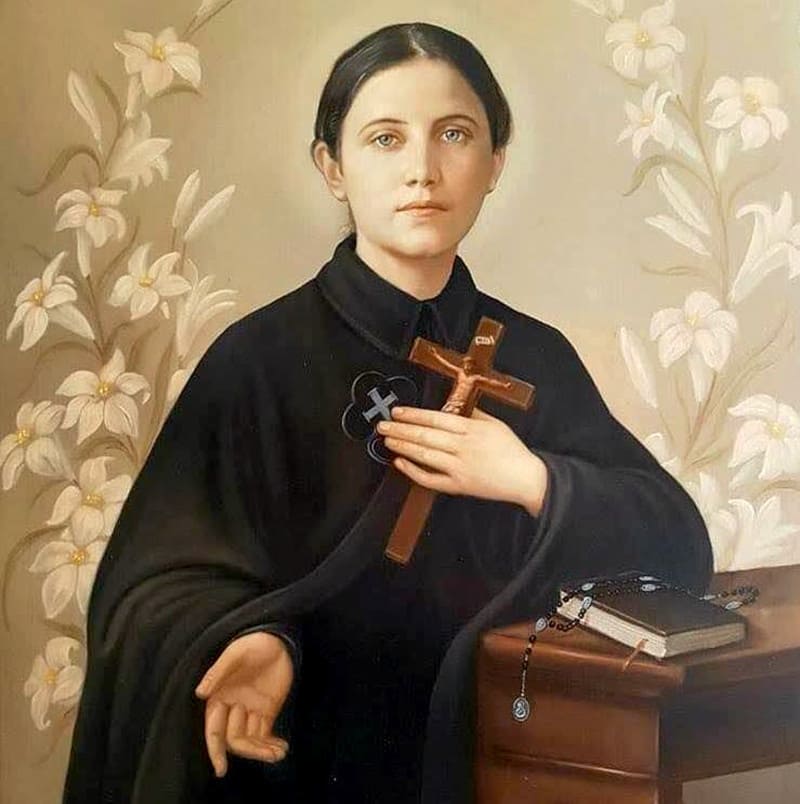 One evening, after speaking at length with her guardian angel, Gemma Galgani heard him order her to bed. "He said that I should stay alone that night because if he stayed, I would never go to sleep. And he left. It is true: I do not sleep when he is here. He tells me about so many things that are done in Heaven, and the night passes very, very quickly. He left me alone, and I slept. Yet I woke up more than once and each time he immediately said,'Sleep, or I will really go.'" It was in this very charming manner that Gemma received profound teachings from Heaven about conforming to God's will. Who was this young girl? Saint Maximilian Kolbe wrote about the young saint in 1921: "I read the Life of Gemma Galgani. It did me more good than a whole series of spiritual exercises."
One evening, after speaking at length with her guardian angel, Gemma Galgani heard him order her to bed. "He said that I should stay alone that night because if he stayed, I would never go to sleep. And he left. It is true: I do not sleep when he is here. He tells me about so many things that are done in Heaven, and the night passes very, very quickly. He left me alone, and I slept. Yet I woke up more than once and each time he immediately said,'Sleep, or I will really go.'" It was in this very charming manner that Gemma received profound teachings from Heaven about conforming to God's will. Who was this young girl? Saint Maximilian Kolbe wrote about the young saint in 1921: "I read the Life of Gemma Galgani. It did me more good than a whole series of spiritual exercises."
Gemma was born on March 12, 1878, in Tuscany, the fifth in a family of eight children. Her mother, Aurelia Landi, wife of Enrico Galgani, a pharmaceutical chemist from Camigliano, was very devout. She would have preferred that her daughter was named after a great saint, but the priest consoled her by saying: "Gemma! It is in Paradise that gems are truly found! Let us hope that she too will be a gem of Paradise." Gemma's mother did all she could to transmit her profound faith to her children. They prayed, attended Mass, and were taught how Jesus gave His life for us. In April 1878, the family moved to the city of Lucca, where Enrico Galgani had bought a very large pharmacy.
In 1881, Gemma attended a nursery school where her lively intelligence manifested itself. Her love of prayer increased greatly. She was about four years old when her grandmother entered her room unexpectedly and found her with her hands clasped, kneeling before an image of the Virgin. "What are you doing, Gemma?" she asked. After gazing at the scene for a while she answered, "I'm reciting the Hail Mary. Leave me alone, I want to pray!" On other occasions, mother and daughter could be found on their knees, united in the same prayer. Aurelia Galgani had contracted tuberculosis; she would not remain on earth more than eight years after Gemma was born. Her mother often said to her: "If only I could take you with me to Heaven!" The day came when the ailing woman could no longer leave her bed. "From then on I did not want to be separated from my mother," Gemma later recalled. "I didn't even leave her room anymore. I wanted to go with her to Paradise and was worried that she would fly off to Heaven alone."
On May 26, 1885, at the age of seven, the child received the Sacrament of Confirmation. On that day for the first time she heard an inner voice. "Gemma," will you give me your mother?" She replied, "Yes, as long as you take me too." The response was "No! Give her to me willingly. For the time being, you must stay with your daddy. l will take her to Heaven, you know." Gemma recounted: "I was obliged to say yes but I cried." She stayed by her dying mother's side. Concerned for his child's life, Mr. Galgani placed her in her aunt's care. Aurelia died on September 17, 1886 at the age of 38, having uttered these words: "I offer my life in order to obtain the grace of seeing my eight children again in Paradise."
10/10 every day
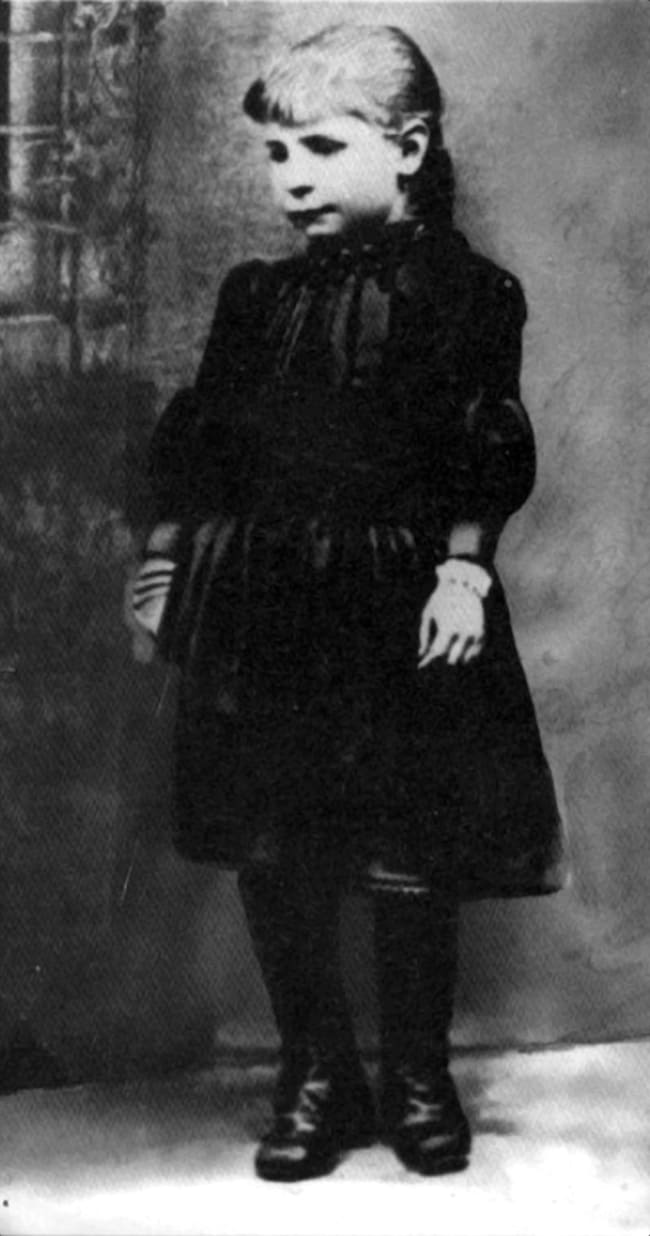 Gemma at 7
Gemma at 7Gemma went to a school run by religious sisters and received her First Holy Communion on June 17, 1887 at the age of nine. She pleaded insistently to receive Communion which was not usually granted to children of that age at the time. Enrico Galgani could no longer bear to see his daughter's tears because she could not receive Communion, and it was the parish priest who advised him to give her this permission, fearing that she would otherwise fall ill. However, Gemma later confessed that she had a bad habit of crying to soften up her father so as to obtain what she wanted. On the day of her First Communion, she discovered how profoundly the delights of Heaven differed from those of the earth. "It was on that morning that Jesus inspired my fervent desire to become a nun," she later wrote to her spiritual father.
At school, Gemma excelled in French, Arithmetic, and Music. But she wanted above all to learn everything about the Passion of Jesus. Her teacher promised that she would explain a particular aspect of it to her each time she earned "a 10 out of 10" in class. "I was so happy as every day I had a 10, and every day I had my explanation," she said. She went on to win the Gold Prize for her knowledge of Catechism. But when she was about 12, her fervor waned and she felt Jesus moving away from her. It was because her father refused her nothing, and she herself took excessive pleasure in showing off her elegant clothes. However, Gemma retained her great love for the poor, and whenever she went out she scoured the house for alms to distribute. Faced with her tendency to lavishness, her confessor, Bishop Volpi (Auxiliary Bishop of Lucca, later Bishop of Arezzo; 1860-1931), finally decided to forbid these bounties, and her father no longer granted her that which would have satisfied her generous heart. She ended up no longer leaving the house, for fear of encountering poor people she would not be able to help.
A bride's jewels
On September 11, 1894, her favorite brother, Gino, died of tuberculosis. He was a seminarian and only 18 years old. Gemma was inconsolable and fell ill for three months. Once she recovered her father surrounded her with loving kindness and showered her with gifts. One day he gave her a gold watch which she wore with delight on an outing. Upon her return, her guardian angel appeared to her for the first time: "Remember that the only precious jewels that can adorn the bride of a crucified King are thorns and the cross." From that day onwards, Gemma stripped her life of many things in order to please Jesus. She dressed soberly, with no other adornment than her clear eyes and celestial smile. She signed her letters "Poor Gemma." Her daily struggle included fighting against her weaknesses and her faults in order to obtain the virtue of humility.
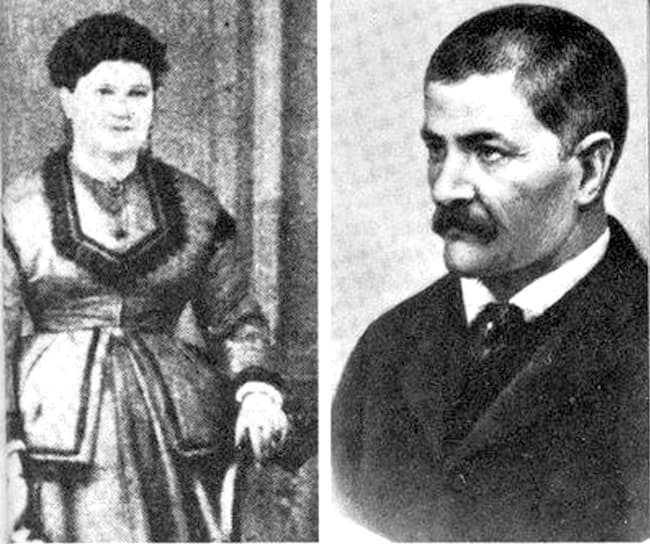 Gemma’s parents
Gemma’s parentsAt Christmas, in her 17th year, Gemma's confessor granted her permission to take a vow of chastity. She would later write to her spiritual father: "That morning at Communion, Jesus said to me,'See, Gemma, in my heart there is a little girl whom I love very much, and by whom I am much loved in return. This girl always asks me for love and purity, and I, who am love and purity, give her as much of them as a human creature can receive.'" Gemma asked Jesus to let her suffer greatly to prove her love for Him. This surprising request was not the expression of a deranged mind. It stemmed from an ardent desire to resemble Jesus in his Passion. By His grace, God gives us the ability to participate in the work of Redemption that bears fruit in the communion of saints.
"'Now you are the body of Christ and individually members of it (1 Cor. 12:27). Charity does not insist on its own way (1 Cor. 13:5). In this solidarity with all men, living or dead, which is founded on the communion of saints, the least of our acts done in charity redounds to the profit of all. Every sin harms this communion. The term'communion of saints'refers also to the communion of'holy persons'(sancti) in Christ who'died for all'so that what each one does or suffers in and for Christ bears fruit for all" (Catechism of the Catholic Church, 953, 961).
Gemma's desire would soon be granted when an abscess appeared on her foot, causing pain that she generously accepted and also did her best to hide so that Jesus alone would know of it. Soon, her ailment deteriorated into bone decay. As the pain worsened, she was compelled to consult doctors who recommended that the bone be scraped to avoid amputation. Gemma later blamed herself for "crying and screaming," but her loved ones and even her doctors were impressed by her silence and her smiles.
Belonging to Jesus
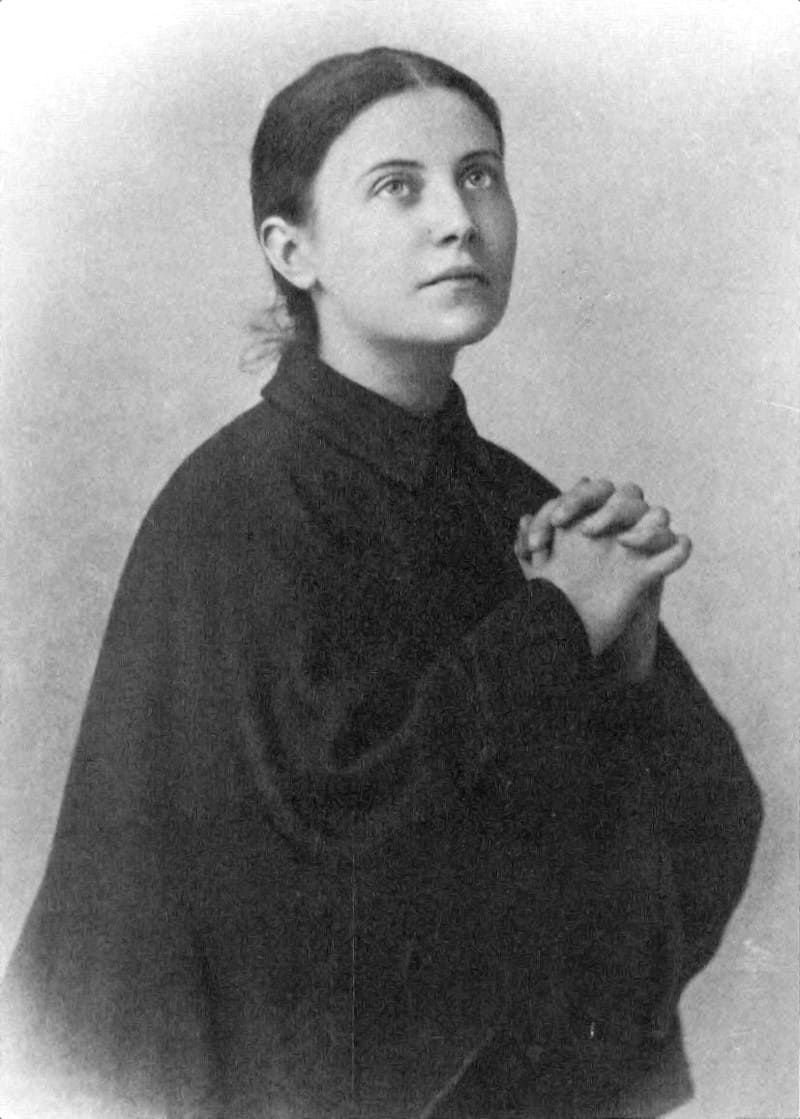 In 1897, Enrico Galgani died of throat cancer. Gemma was deeply affected by the loss, but Jesus gave her inner strength. She was sent to live with her paternal aunt, whom she helped to run a hardware store. Several young men asked for her hand but she declined these offers as she wanted to belong to Jesus alone. Back pain forced her to return to Lucca. In reality, Gemma was suffering from Pott's Disease, a tuberculosis of the bones affecting the spine. Paralysis soon set in; she could no longer rise from her bed. Her greatest suffering was caused by her doctors'examinations for she took great care to preserve purity of body and mind. "I used always to make sure to recite three Ave Marias, kneeling every day, with my knees on my fingers–a penitential practice my mother taught me–so that Jesus might set me free from sins against the holy virtue of purity."
In 1897, Enrico Galgani died of throat cancer. Gemma was deeply affected by the loss, but Jesus gave her inner strength. She was sent to live with her paternal aunt, whom she helped to run a hardware store. Several young men asked for her hand but she declined these offers as she wanted to belong to Jesus alone. Back pain forced her to return to Lucca. In reality, Gemma was suffering from Pott's Disease, a tuberculosis of the bones affecting the spine. Paralysis soon set in; she could no longer rise from her bed. Her greatest suffering was caused by her doctors'examinations for she took great care to preserve purity of body and mind. "I used always to make sure to recite three Ave Marias, kneeling every day, with my knees on my fingers–a penitential practice my mother taught me–so that Jesus might set me free from sins against the holy virtue of purity."
"Purity requires modesty, an integral part of temperance... It is ordered to chastity to whose sensitivity it bears witness. It guides how one looks at others and behaves toward them in conformity with the dignity of persons and their solidarity. Modesty is decency. It inspires one's choice of clothing. It keeps silence or reserve where there is evident risk of unhealthy curiosity. It inspires a way of life which makes it possible to resist the allurements of fashion and the pressures of prevailing ideologies. Modesty is born with the awakening consciousness of being a subject. Teaching modesty to children and adolescents means awakening in them respect for the human person" (CCC, 2521-2524).
In his encyclical, Sacra Virginitas, Pope Pius XII said, "To preserve unstained chastity neither vigilance nor modesty suffice. Those helps must also be used which entirely surpass the powers of nature, namely prayer to God, the Sacraments of Penance and Holy Eucharist, and a fervent devotion to the most holy Mother of God" (March 25, 1954, 59).
Gemma later confided that after any suffering she would be disappointed that her strength returned for she saw in death the gateway to Paradise. Nuns of the Visitation who came to care for her suggested she pray a novena to St. Margaret Mary, to help her either to heal or to die well. It was then that she read with great delight the life of young Saint Gabriel of the Sorrowful Mother, who died in 1862 at the age of 24, and was canonized in 1920. A great spiritual friendship developed and Brother Gabriel appeared to her every evening to help her pray the novena. Afterwards, he would often speak with her. At the end of the novena, Gemma was completely cured, much to the amazement of her doctors. One of them suspected her of hysteria. Although she was hurt by the suspicion it did not disturb the profound peace of her soul. She considered joining the Order of the Visitation, but Brother Gabriel advised her to commit solely to becoming a nun and devoting herself to the Sacred Heart. When she asked him why, his answer was enigmatic: "Sorella mia! (My Little Sister!)"
Intimate friends
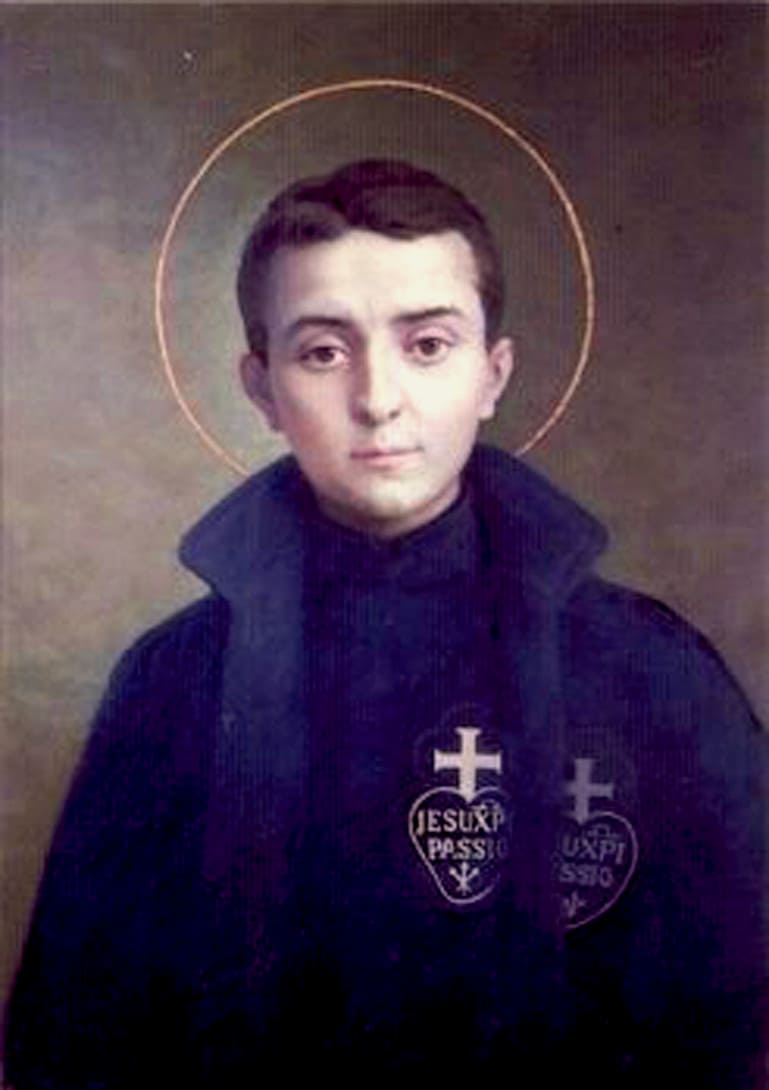 St. Gabriel of the Sorrowful Mother
St. Gabriel of the Sorrowful MotherWhat truly characterized Gemma's life was its simplicity and monotony, combined with her extraordinary familiarity with the supernatural world. She talked to angels and saints as if they were intimate friends. The diary she wrote in obedience to her spiritual director bears witness to this. On Holy Thursday, March 30, 1899, the crucified Jesus spoke to her: "Look, my daughter, and learn how one should love. Do you see this cross, these thorns, these wounds? They are the works of love; and of infinite love. Do you see to what extent I have loved you? Do you really want to love me? First, learn to suffer; suffering teaches how to love." The next day, Our Lord gave her Holy Communion from His hand for the first time, because she was ill and was not allowed to attend services. She united herself to the Good Friday observances from her room. "My guardian angel came and we prayed together. We assisted Jesus in all His sorrows; we shared the sorrows of our dear Mother (so did she call the Blessed Virgin). But my angel also gently reproached me, telling me not to weep when l had some sacrifice to offer Jesus, but to thank those who gave me the opportunity to do so."
In his encyclical, Spe salvi (40), Pope Benedict XVI recalls the meaning of small sacrifices: "There used to be a form of devotion–perhaps less practiced today but quite widespread not long ago–that included the idea of'offering up'the minor daily hardships that continually strike at us like irritating jabs, thereby giving them a meaning... We need to ask ourselves whether there may not after all have been something essential and helpful contained within it. What does it mean to offer something up? Those who did so were convinced that they could insert these little annoyances into Christ's'great compassion'so that they somehow became part of the treasury of compassion so greatly needed by the human race. In this way, even the small inconveniences of daily life could acquire meaning and contribute to the economy of good and of human love. Maybe we should consider whether it might be judicious to revive this practice ourselves."
In May 1899, Gemma asked to join the Order of the Visitation in Lucca, but her precarious state of health prevented her admission. On the following 8th of June, eve of the Feast of the Sacred Heart, she received the grace of the stigmata in her hands and side. "Jesus appeared with His wounds open," Gemma recounted, "but it was no longer blood that came out of those wounds. Instead, flames of fire issued forth from them. In a short instant these flames came to touch my hands, my feet, and my heart, I felt as if I were dying. I would have fallen to the floor if my Mother (the Virgin Mary) had not held me up."
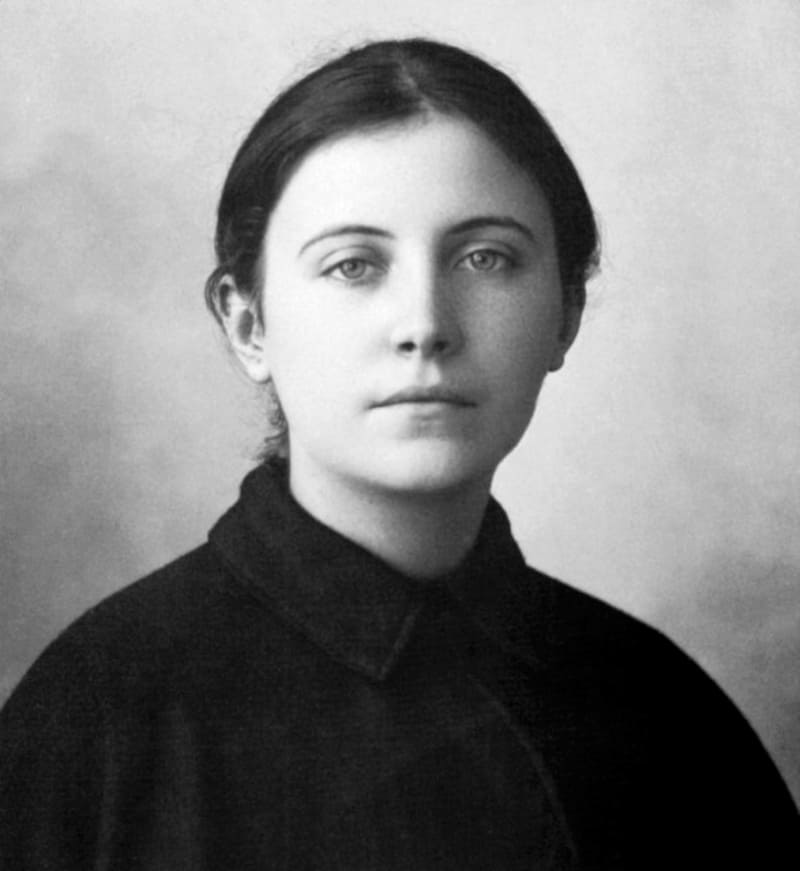
Hours of suffering and joy
Until her death, Gemma relived the Passion each week, from Thursday at 8 p.m. to Friday at 3 p.m., bearing in her hands, feet and side the stigmata, the marks of God's love for mankind. At the same time Jesus Himself imposed on her His crown of thorns. Gemma was overcome with feelings of gratitude, for she was thus able to offer Jesus some relief and show Him her love. These hours of suffering were also hours of joy because of the strong intimacy she felt with the Saviour. She interceded for those she loved, and also for sinners. In addition, Gemma asked forgiveness for her own sins.
"In bringing about the Redemption through suffering," wrote Pope John Paul II, "Christ has also raised human suffering to the level of the Redemption. Thus each man, in his suffering, can also become a sharer in the redemptive suffering of Christ" (Apostolic Letter, Salvifici Doloris, February 11, 1984, 19). Gemma Calgani was united to the Cross of Christ in a very special way. But we all must suffer out of loyalty to truth, justice and love:
"To suffer with the other and for others," said Pope Benedict XVI, "to suffer for the sake of truth and justice; to suffer out of love and in order to become a person who truly loves–these are fundamental elements of humanity, and to abandon them would destroy man himself... Are we capable of this? Is the other important enough to warrant my becoming, on his account, a person who suffers? Does truth matter to me enough to make suffering worthwhile? Is the promise of love so great that it justifies the gift of myself? In the history of humanity, it was the Christian faith that had the particular merit of bringing forth within man a new and deeper capacity for these kinds of suffering that are decisive for his humanity. The Christian faith has shown us that truth, justice and love are not simply ideals, but enormous weighty realities. It has shown us that God –Truth and Love in person – desired to suffer for us and with us" (Spe Salvi, 39).
Young Gemma did her best to hide the stigmata. Bishop Volpi, who was troubled by these events, often put Gemma to the test. He wanted a doctor to examine the stigmata. Despite a letter from Gemma ordering him, on behalf of Jesus, to come alone, lest he not see anything, he came accompanied by a doctor to see her in ecstasy. The doctor cleaned the wounds with cotton. This absorbed the blood and left the skin intact. He was adamant that this was a case of hysteria and that the young girl must have been pricking herself with needles. Gemma's loved ones began to doubt the truth of the supernatural phenomena. The stigmata's disappearance in the presence of the doctor tested her humility.
A favourite daughter
 The Passionist convent in Lucca
The Passionist convent in LuccaIn the early summer of 1899, Passionist religious members (the congregation founded in the 18th century by St. Paul of the Cross) preached a mission in Lucca. Gemma was surprised to see that the priests wore the same habit as her spiritual brother, Gabriel! It was then that she heard Jesus ask her, in her heart: "Would it please you to wear the same habit?... You shall be a daughter of my Passion, and a favorite daughter! One of those will be your Father. Go and explain everything!" Gemma confided in one of the Fathers, who forbade her from engaging in a number of extraordinary penances, which she had imposed upon herself without permission. He then introduced her to the Giannini family where she lived from then on and was hidden from the eyes of the world. The family, who had 12 children, gladly welcomed Gemma into their home because they appreciated her virtue and piety. She was then put in touch with Father Germano, a Passionist priest, who would guide her safely and firmly. Gemma wrote to him often. She obeyed him in all things, even going so far as to send Jesus away when her allotted time for prayer ended. This obedience protected her from diabolical illusions. Father Germano, discerning that hers was a true mystical life, was very careful to let the Holy Spirit work within her.
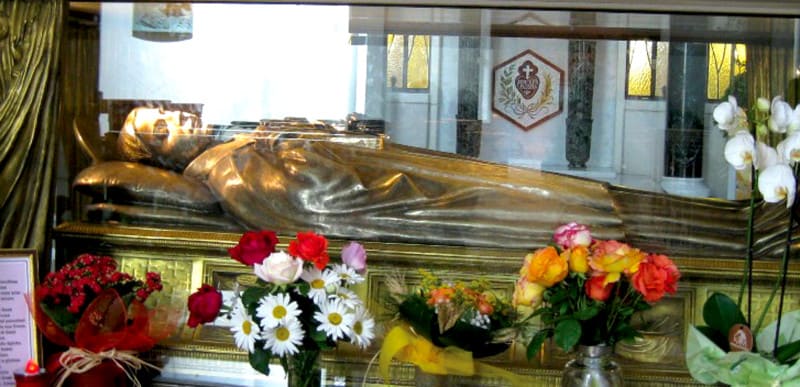 Gemma’s tomb in the convent
Gemma’s tomb in the conventGemma's existence continued in this way, full of self-effacement and in humble service to others. She diligently helped with the housework, mending socks and taking care of everyone's clothes. Ecstasy would often seize her where she stood, and once it was over, Gemma would simply continue in silence with her work. She ardently desired, in vain, to enter a religious order. The Passionist nuns were afraid to welcome as a postulant someone with such an extraordinary spiritual life. Her endeavors to found a convent of Passionist Sisters in Lucca were also unsuccessful. Following Pentecost in 1902, she fell ill and stopped eating; Holy Communion became her only nourishment. It was a period of intense "reparation" offered to the Sacred Heart, and of special intercession for the sanctification of the clergy.
On September 21st the first obvious symptoms of pulmonary tuberculosis appeared. Our Lord revealed to her that she would once again go through a painful Calvary: "I need immense atonement, especially for the sins and sacrileges by which I am outrageously affronted by ministers of the sanctuary." The torments that she endured for several months were indescribable, but her patience never failed. Her unconditional love for God allowed her to see the "scandal of evil" and of suffering in His light. In January, 1903 she was transferred to a small isolated room to prevent contagion. It was there that she died on Holy Saturday, April 11, 1903, at the age of 25.
The Passionist convent in Lucca
The Passionist convent in Lucca whose foundation she had so ardently desired, opened in 1905. It received the mortal remains of its heavenly patroness who had prophesied, "The Passionists did not want me alive, but they will have me dead." On May 2, 1940, Pope Pius XII canonized Gemma after a thorough investigation of the mystical phenomena in her life.
Saint Gemma Galgani, obtain for us from Jesus and Mary the grace of patience, for the love of the crucified Jesus!
Dom Jean-Bernard Marie, osb
eand the monks of the Abbey
This article is adapted and reprinted with permission from the Abbey of Clairval, France, which every month publishes a spiritual newsletter on the life of a saint, in English, French, Italian and Dutch. Their postal address is Abbaye Saint-Joseph de Clairval 21150 Flavigny sur Ozerain, France. Their website is www.clairval.com.